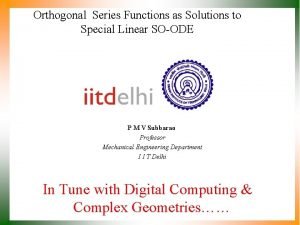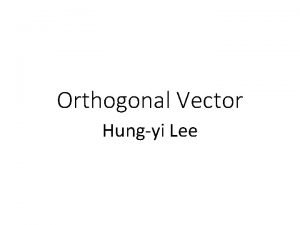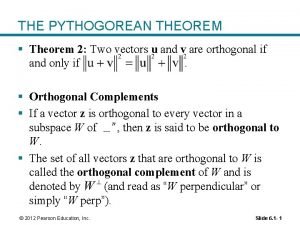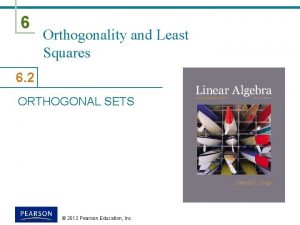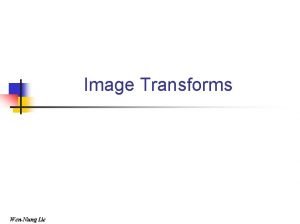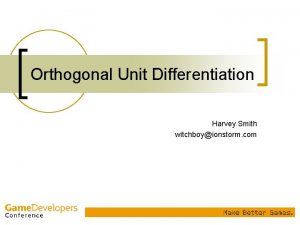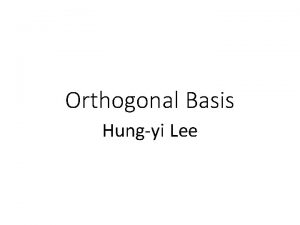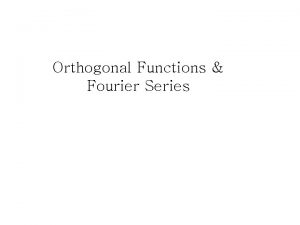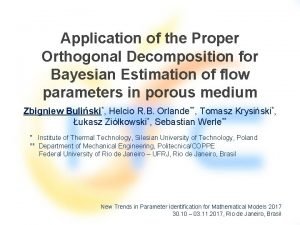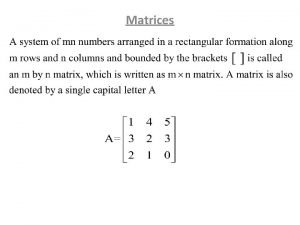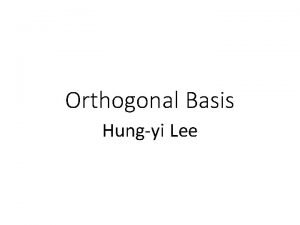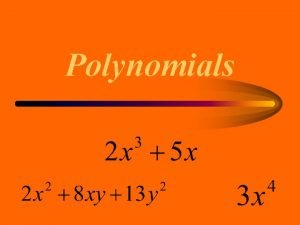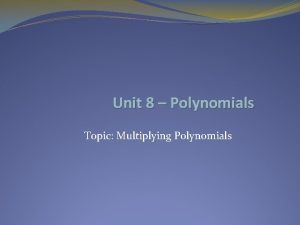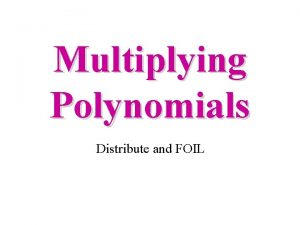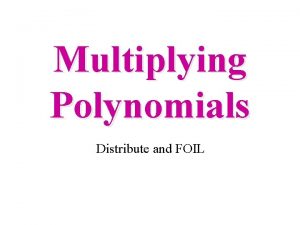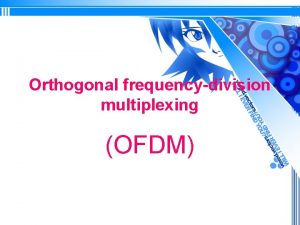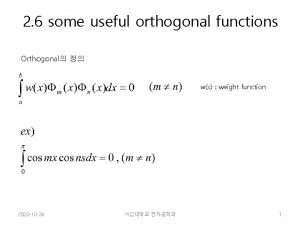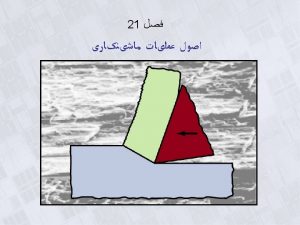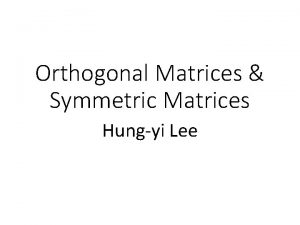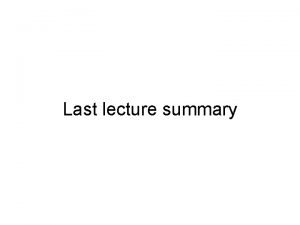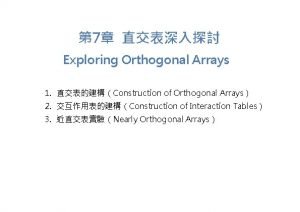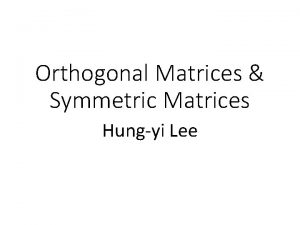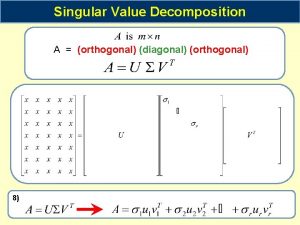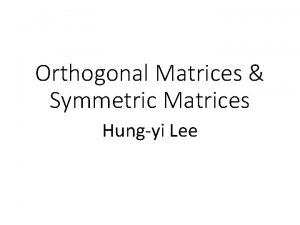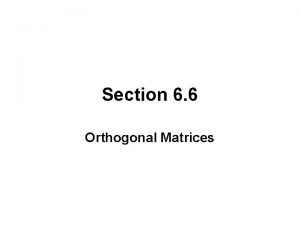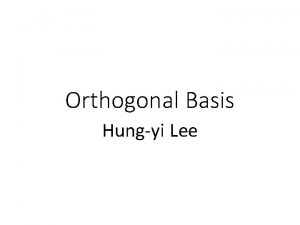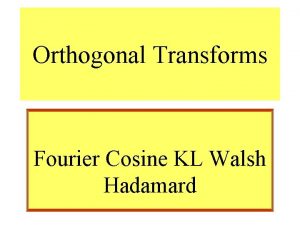Orthogonal moments set of orthogonal polynomials Motivation for

























































































- Slides: 89


Orthogonal moments - set of orthogonal polynomials Motivation for using OG moments • Stable calculation by recurrent relations • Easier and stable image reconstruction

Numerical stability How to avoid numerical problems with high dynamic range of geometric moments?

Standard powers

Orthogonal polynomials Calculation using recurrent relations

Two kinds of orthogonality • Moments (polynomials) orthogonal on a unit square • Moments (polynomials) orthogonal on a unit disk

Moments orthogonal on a square is a system of 1 D orthogonal polynomials

Common 1 D orthogonal polynomials • • • Legendre <-1, 1> Chebyshev <-1, 1> Gegenbauer <-1, 1> Jacobi <-1, 1> or <0, 1> (generalized) Laguerre <0, ∞) Hermite (-∞, ∞)

Legendre polynomials Definition Orthogonality

Legendre polynomials explicitly

Legendre polynomials in 1 D

Legendre polynomials in 2 D

Legendre polynomials Recurrent relation

Legendre moments

Moments orthogonal on a disk Radial part Angular part

Moments orthogonal on a disk • • • Zernike Pseudo-Zernike Orthogonal Fourier-Mellin Jacobi-Fourier Chebyshev-Fourier Radial harmonic Fourier

Zernike polynomials Definition Orthogonality

Zernike polynomials – radial part in 1 D

Zernike polynomials – radial part in 2 D

Zernike polynomials

Zernike moments Mapping of Cartesian coordinates x, y to polar coordinates r, φ: • Whole image is mapped inside the unit disk • Translation and scaling invariance

Zernike moments

Rotation property of Zernike moments The magnitude is preserved, the phase is shifted by ℓθ. Invariants are constructed by phase cancellation

Zernike rotation invariants Phase cancellation by multiplication Normalization to rotation

Recognition by Zernike rotation invariants

Insufficient separability

Sufficient separability

Image reconstruction • Direct reconstruction from geometric moments • Solution of a system of equations • Works for very small images only • For larger images the system is ill-conditioned

Image reconstruction by direct computation 12 x 12 13 x 13

Image reconstruction • Reconstruction from geometric moments via FT

Image reconstruction via Fourier transform

Image reconstruction • Image reconstruction from OG moments on a square • Image reconstruction from OG moments on a disk (Zernike)

Image reconstruction from Legendre moments

Image reconstruction from Zernike moments Better for polar raster

Image reconstruction from Zernike moments

Reconstruction of a noise-free image

Reconstruction of a noisy image

Reconstruction of a noisy image

Summary of OG moments • OG moments are used because of their favorable numerical properties, not because of theoretical contribution • OG moments should be never used outside the area of orthogonality • OG moments should be always calculated by recurrent relations, not by expanding into powers • Moments OG on a square do not provide easy rotation invariance • Even if the reconstruction from OG moments is seemingly simple, moments are not a good tool for image compression

Algorithms for moment computation Various definitions of moments in a discrete domain depending on the image model Sum of Dirac δ-functions Nearest neighbor interpolation Bilinear interpolation

Moments in a discrete domain exact formula

Moments in a discrete domain zero-order approximation

Moments in a discrete domain exact formula

Algorithms for binary images • Decomposition methods • Boundary-based methods

Decomposition methods The object is decomposed into K disjoint (usually rectangular) “blocks” such that

Decomposition methods differ from each other by - the decomposition algorithms - the shape of the blocks - the way how the moments of the blocks are calculated

Delta method (Zakaria et al. ) Decomposition into rows

Recursive formulae for the summations where

Delta method (Zakaria et al. ) Decomposition into rows Simplification by direct integration

Delta method (Zakaria et al. )

Rectangular blocks (Spiliotis et al. ) Decomposition into sets of rows of the same beginning and end Simplification by direct integration

Hierarchical decomposition Bin-tree/quad-tree decomposition into homogeneous squares Moment of a block by direct integration

Quadtree decomposition – an example

Quadtree decomposition – an example

Morphological decomposition (Sossa et al. ) Recursive decomposition into the “largest inscribed squares” Square centers are found by erosion Moment of a block by direct integration

Morphological decomposition into squares

Morphological decomposition into rectangles

Decomposition by distance transform

Optimal decomposition

Optimal decomposition

Optimal decomposition

Optimal decomposition

Optimal decomposition

Decompositions – a comparison

Moment calculation – the squirrel

Moment calculation – the squirrel

Moment calculation – the chessboard

Decomposition methods - complexity • Complexity of the decomposition is often ignored (believed to be O(1)) but it might be very high – it must be always considered • Efficient when calculating a large number of moments of the object • Certain objects cannot be efficiently decomposed at all (a chessboard)

Decomposition for computing convolution • Convolution with a constant rectangle – O(1) per image pixel (with pre-calculations)

Decomposition for computing convolution • Convolution with a constant rectangle – O(1) per image pixel (with pre-calculations) • Convolution with a binary kernel - kernel decomposition into K blocks - O(K) per pixel

Decomposition for computing convolution • Convolution with a constant rectangle – O(1) per image pixel (with pre-calculations) • Convolution with a binary kernel - kernel decomposition into K blocks - O(K) per pixel

Boundary-based methods Green’s theorem →

Calculation of the boundary integral • Summation pixel-by-pixel • Polygonal approximation • Other approximations (splines, etc. )

Discrete Green’s theorem (Philips) • Equivalent to the delta-method • Can be simplified by direct integration and further by pre-calculations (efficient for large number of objects)

Boundary-based methods - complexity • Complexity depends on the length of the boundary • Detecting boundary is assumed to be fast • Efficient for objects with simple boundary • Unlike decomposition methods, they can be used even for small number of moments • Inefficient for objects with complex boundaries (a chessboard)

Moments of gray-level images • Decomposition into several binary images (intensity slices, bit planes) • Approximation of graylevels

Intensity slicing

Intensity slicing

Bit-plane slices fk(x, y) is the k-th bit plane of the image Low bit planes are often ignored

Bit-plane slices

A detail of the zero-bit plane

Approximation methods The image is decomposed into blocks where it can be approximated by an “easy-to-integrate” function (e. g. by polynomials) Any kind of decomposition can be used.

Polynomial approximation of graylevels

Algorithms for OG moments Specific methods • Methods using recurrent relations • Decomposition methods • Boundary-based methods


Are moments good features? • YES - well-developed mathematics behind, invariance to many transformations - complete and independent set - good discrimination power - robust to noise • NO - moments are global - small local disturbance affects all moments - careful object segmentation is required

How to make the moment invariants local?

Dividing the object into invariant parts • Inflection points and centers of straight lines are affine invariants • Computing the AMI’s of each part • Recognition via maximum substring matching

Thank you ! Any questions?
 Total set awareness set consideration set
Total set awareness set consideration set Training set validation set test set
Training set validation set test set Orthogonal polynomials examples
Orthogonal polynomials examples Define orthogonal set
Define orthogonal set Pythogor
Pythogor Orthnormal
Orthnormal Bruner and minturn
Bruner and minturn Crisp set vs fuzzy set
Crisp set vs fuzzy set Crisp set vs fuzzy set
Crisp set vs fuzzy set Bounded set vs centered set
Bounded set vs centered set What is the overlap of data set 1 and data set 2?
What is the overlap of data set 1 and data set 2? Fuzzy logic
Fuzzy logic Surjective vs injective
Surjective vs injective Cks
Cks Påbyggnader för flakfordon
Påbyggnader för flakfordon Urban torhamn
Urban torhamn Sura för anatom
Sura för anatom Karttecken brant
Karttecken brant Egg för emanuel
Egg för emanuel Trög för kemist
Trög för kemist Stickprovsvarians
Stickprovsvarians Multiplikation uppställning
Multiplikation uppställning Tack för att ni har lyssnat
Tack för att ni har lyssnat Elektronik för barn
Elektronik för barn Rutin för avvikelsehantering
Rutin för avvikelsehantering Klassificeringsstruktur för kommunala verksamheter
Klassificeringsstruktur för kommunala verksamheter Fspos
Fspos Debattartikel struktur
Debattartikel struktur Bris för vuxna
Bris för vuxna Etik och ledarskap etisk kod för chefer
Etik och ledarskap etisk kod för chefer En lathund för arbete med kontinuitetshantering
En lathund för arbete med kontinuitetshantering Tobinskatten för och nackdelar
Tobinskatten för och nackdelar Indikation för kejsarsnitt på moderns önskan
Indikation för kejsarsnitt på moderns önskan Atmosfr
Atmosfr Programskede byggprocessen
Programskede byggprocessen Kraft per area
Kraft per area Presentera för publik crossboss
Presentera för publik crossboss Förklara densitet för barn
Förklara densitet för barn Ramsa geometriska former
Ramsa geometriska former Nationell inriktning för artificiell intelligens
Nationell inriktning för artificiell intelligens Tack för att ni har lyssnat
Tack för att ni har lyssnat Rap texter som rimmar
Rap texter som rimmar Smärtskolan kunskap för livet
Smärtskolan kunskap för livet Referatmarkering
Referatmarkering Antika plagg
Antika plagg Novell typiska drag
Novell typiska drag Epiteltyper
Epiteltyper Delegerande ledarskap
Delegerande ledarskap Jätte råtta
Jätte råtta Blomman för dagen drog
Blomman för dagen drog Exspektans eller expektans
Exspektans eller expektans Adressändring ideell förening
Adressändring ideell förening Tillitsbaserad ledning
Tillitsbaserad ledning Borra hål för knoppar
Borra hål för knoppar Sju för caesar
Sju för caesar Mat för idrottare
Mat för idrottare Teckenspråk minoritetsspråk argument
Teckenspråk minoritetsspråk argument Datorkunskap för nybörjare
Datorkunskap för nybörjare Shivaiter
Shivaiter Returpilarna
Returpilarna Rita perspektiv
Rita perspektiv Inköpsprocessen steg för steg
Inköpsprocessen steg för steg Strategi för svensk viltförvaltning
Strategi för svensk viltförvaltning Ministerstyre för och nackdelar
Ministerstyre för och nackdelar Redogör för vad psykologi är
Redogör för vad psykologi är Bästa kameran för astrofoto
Bästa kameran för astrofoto Svenskt ramverk för digital samverkan
Svenskt ramverk för digital samverkan Nyckelkompetenser för livslångt lärande
Nyckelkompetenser för livslångt lärande Datumr
Datumr Myndigheten för delaktighet
Myndigheten för delaktighet Tidbok yrkesförare
Tidbok yrkesförare Läkarutlåtande för livränta
Läkarutlåtande för livränta Orubbliga rättigheter
Orubbliga rättigheter Tack för att ni lyssnade
Tack för att ni lyssnade Verktyg för automatisering av utbetalningar
Verktyg för automatisering av utbetalningar Plats för toran ark
Plats för toran ark Tack för att ni lyssnade bild
Tack för att ni lyssnade bild Mitos steg
Mitos steg Rådet för byggkompetens
Rådet för byggkompetens Varför kallas perioden 1918-1939 för mellankrigstiden?
Varför kallas perioden 1918-1939 för mellankrigstiden? Vad är verksamhetsanalys
Vad är verksamhetsanalys Kung som dog 1611
Kung som dog 1611 Borstål, egenskaper
Borstål, egenskaper 2d orthogonal and unitary transforms
2d orthogonal and unitary transforms Orthogonal unit differentiation
Orthogonal unit differentiation Orthogonal
Orthogonal Fourier sine series
Fourier sine series Orthogonal decomposition
Orthogonal decomposition Orthogonal matrix meaning
Orthogonal matrix meaning Orthonormal basis
Orthonormal basis


